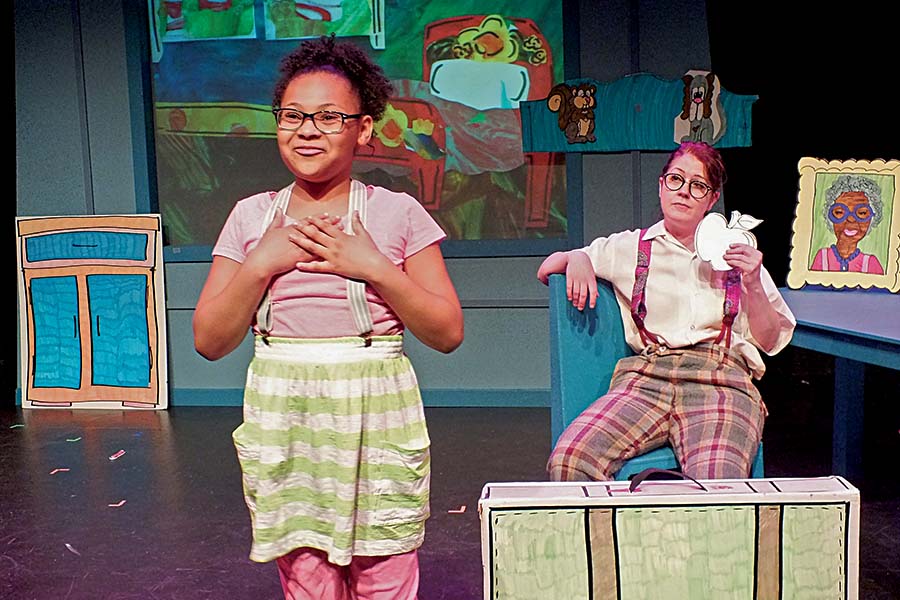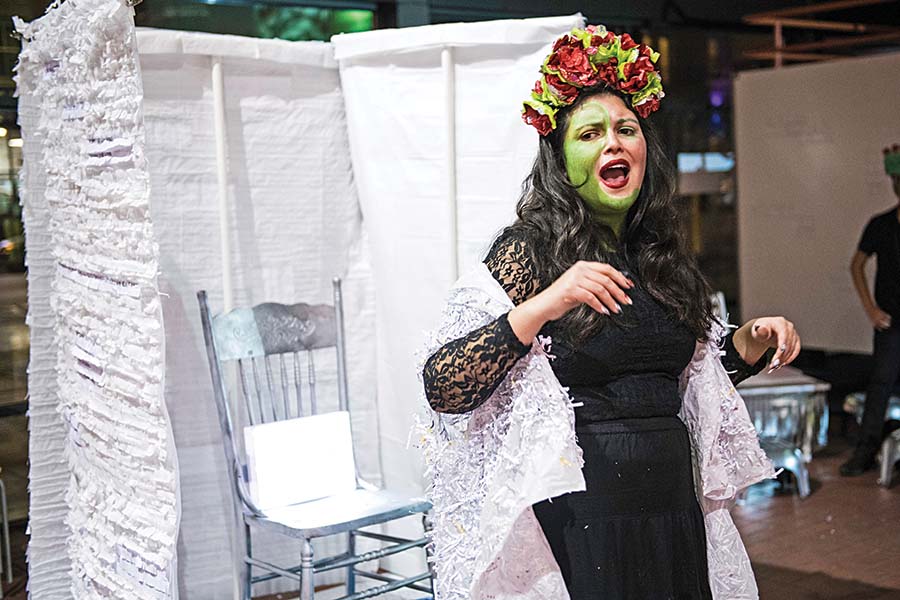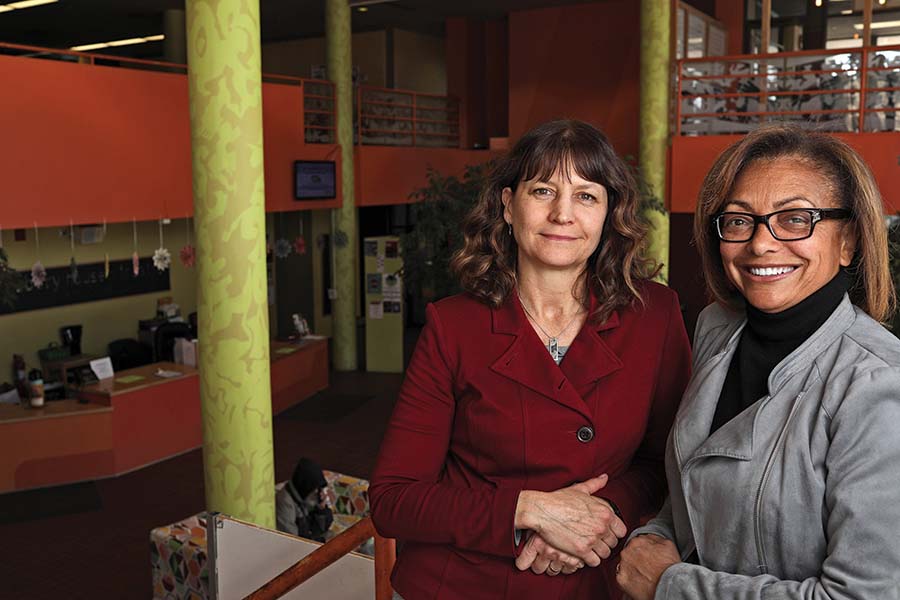“How do you democratize the space?”
This question lives in the minds of Noël Raymond and Faye Price, co-artistic managing director and co-artistic producing director, respectively, of Pillsbury House + Theatre—abbreviated as PH+T—in Minneapolis.
PH+T can be tricky to describe. Do you start by explaining that the company is a part of Pillsbury United Communities, an organization that works with underserved populations throughout the City of Minneapolis, striving to foster resilience and community? Or do you lead with their robust array of life-enhancing programs serving the neighborhoods around them? Or the mainstage theatrical season that showcases local playwrights and performance artists?
PH+T does all of these things, and Raymond and Price don’t put a premium on any single aspect of PH+T’s eclectic services and programming. But the overarching thing that can be said of PH+T is that the arts are integrated into every aspect of the work the company undertakes.
Raymond will tell you she believes that theatre and the arts have “a unique capacity to bring people together and transform how they see each other, and how they see themselves in the context of society and the larger world.” If folks go to PH+T to have their taxes prepared by qualified volunteers—a service the company offers—they might see an exhibit of African art. Or if they visit the free clinic to receive acupuncture, they might hear a new play being read aloud in the lobby.
This approach isn’t brand new, Price is quick to point out. Pillsbury House grew out of the settlement house tradition made famous in the United States by Jane Addams of Hull-House in Chicago. Beginning in the 1880s and peaking in the 1920s, Hull-House and the organizations it inspired brought together people of different classes and backgrounds and provided services ranging from day care to health care. To foster connection and communication among the immigrants Hull-House served, Addams encouraged the groups to share and perform their culture.
“Theatre became a language of transcendence,” Price explains. Like Hull-House, PH+T is a purveyor of social services as well as opportunities for different groups in the neighborhood to get involved in art-making. “We’re doing the same kind of work. We know that theatre is powerful, and we’re doing it quite purposefully.”
That sense of purpose comes with a feeling of urgency. PH+T sits at the crossroads of four neighborhoods whose residents hail from around the world—none of whom, Price points out, are particularly well off. These Minnesotans are directly affected by political decisions at the local and national level, by the state of DACA, by police shootings of people of color. Their urgency also flows from the knowledge that Minnesota was recently ranked second in the nation for highest racial disparities in income, home ownership, incarceration, and unemployment, according to a study by financial news publication 24/7 Wall St.
So, when Raymond wonders how to “democratize a space,” it’s not an idle or rhetorical question. It’s critical. For PH+T, community engagement isn’t just a buzzword, or a way to bring more people into the space to see existing programming. That mindset, Raymond says, is something she’s seen enough of. Instead, PH+T seeks to be “radically porous”—a term its organizers picked up at a training conference—and asks, “What is it about this community that we have to adapt to?”
Accordingly, Raymond and Price constantly revise the ways they infuse PH+T’s social service programs with the arts. Several teaching artists work with the company’s social-services staff to brainstorm, implement, and revise. Currently, for example, people making the rounds for one of PH+T’s home visiting programs bring along a simple parachute-making activity, which can prove remarkably appealing to neighborhood youngsters. “We’re seen as a punitive agency until a relationship is really established,” Raymond notes. “The purpose of the art activity is to help build a relationship without having to sit across from people and feel like you’re some kind of authority, and they’re somebody with needs.”
The parachute-making gives kids something creative to do, which in short order gets their parents involved too. Then everyone is creating something together and having a conversation—much better, Raymond suggests, than just asking someone to fill out a form.

As co-directors of PH+T, Price and Raymond share a conviction about theatre’s multifarious uses. Both were attracted to the art form from an early age, Price because she was a “performative child,” and Raymond because she loved the collaborative, problem-solving aspects of theatre. Both grew up with mothers who worked in health care and spent lots of time at their parents’ workplaces. “That was a comfortable place for me,” Price remembers. “That meant something positive.”
Both pursued extensive training as actors—Price has also worked as a dramaturg, and both have directed—which dovetails neatly with their experience working with underestimated populations. Both say they realized that despite the attractions of a more conventional theatre career, they wanted to continue using the power of theatre in a social-service vein. Price felt this most keenly when she was cast in the company of a large-scale musical at the Guthrie Theater. “The budget for that musical blew my mind,” Price recalls. “I actually started crying, wondering, ‘Where’s my little political theatre going to go?’”
Raymond and Price came to PH+T at different times in different roles, but since becoming co-directors in 2008, they’ve developed a real partnership. “It’s awesome to have somebody else to make hard decisions with,” declares Raymond. “This kind of partnership, involving collaboration and creative practice, is embedded in the way we function, and the leadership structure is an extension of that.”
“We’re not the only co-artistic directorship in the world,” Price chimes in. “But I don’t know if there are two women leading another theatre somewhere—particularly two women of different races leading a theatre. That’s really quite remarkable in the American theatre.”
Creative community liaison Mike Hoyt, who’s worked at PH+T for nine years, says Price and Raymond “lead in a way that works to diffuse power.” This is evident in the way they foreground arts-integrated work and praise their staff, volunteers, program participants, and members of their community. It’s also part of the lens through which they view the goals for the neighborhoods and people they serve.
“We’re just trying to think about how to keep building the actual physical landscape of the neighborhood in a creative, arts-infused kind of way that doesn’t displace people,” Raymond explains.

The fact is that the Minneapolis community doesn’t need to go to PH+T to experience art. Besides the aforementioned arts-focused home visits, PH+T runs a variety of programs that take art out into adjacent areas of the city. Art Blocks, in particular, calls on artists of different stripes to serve as block captains in their own neighborhoods, bringing residents together to develop community art projects. Both Price and Raymond have witnessed the power of community imagination via Art Blocks, and they daydream about the program taking off throughout the whole city—indeed the entire country. “If literally everybody was doing that,” Raymond figures, “it would be a transformed world.”
For the people who participate in PH+T’s programs, transformation is a more personal phenomenon. Price and Raymond describe a young woman named Michelle, who at age 9 was involved in the Chicago Avenue Project, an after-school program that brings together artists and students to create an original play. Michelle went on to participate in other PH+T programs throughout her high school years. The day before she left for college, Michelle told Raymond: “If Pillsbury House had a kid, it would be me.” After graduating from college, Michelle came back to PH+T to work in the very programs that had helped shape her from childhood.
Many of the company’s youth programs culminate in performances, but the goal of these programs and PH+T’s other offerings isn’t necessarily about ensuring that participants continue to make their own art years after graduating. The focus, more accurately, is on giving young people opportunities and space to uncover and use their voices. “We want the kids to discover a sense of their own power,” Raymond reasons. During one school residency at Green Central Park School, students spent seven weeks working with three teaching artists to develop a play of their own creation. They ultimately performed their piece for 100 peers, who whooped and clapped and cheered for everything they liked. Such an event amounts to far more than performance training.
PH+T’s programs, all free of charge, are tailored to high school-aged students as well as the younger set. FANS Scholars is a college-and-life-prep program, in which participants learn about career options, enjoy academic support and mentorship, and take classes for ACT/SAT prep, and receive other benefits. Students who complete the program are eligible for a scholarship to assist with college expenses.
Power of Our Voices uses theatre to reach teens at risk of dropping out or not finishing school. “POV’s goal is not to develop talented performers,” says the description on PH+T’s website. “Broadly speaking, the POV vision for participants is to develop leadership skills, acquire vocational strategies, improve academic performance, and connect with community resources.” Using theatre as a means toward an end—not an end in itself—is emblematic of the arts-integrated work of PH+T.
Price and Raymond’s focus on access and community carries through to the mainstage season, a part of Naked Stages, and to PH+T’s Late Nite series. Many mainstage productions are world premieres, and some of those are commissions, as in the case of a series called the Great Divide. The two installments of the series so far feature five brand-new short plays by five local playwrights that speak to contemporary aspects of U.S. politics and culture. The first installment went up April 2017, in the aftermath of the presidential election and inauguration, and responded nimbly to the political moment; there were lively talkbacks after each performance.
The Great Divide and all of PH+T’s theatrical offerings are pay-what-you-want, a model Price and Raymond adopted a few years ago. Since then, they’ve actually seen box-office revenue increase. Because of this model, PH+T’s audiences are more diverse than the predominant theatregoing demographic. “Chances are you’re going to be seated next to somebody that’s very different than you,” Price ventures. “I think that’s part of the amazing audience experience.”
Removing barriers to access is something Price and Raymond are always exploring. “How do you disrupt the system and participate in it at the same time?” Raymond asks, answering her own question with a concept called “stealth art.” Drawing upon material she presented at the National Innovation Summit for Arts & Culture in Denver in 2013, Raymond defines the term as “art embedded in neighborhoods in such a way that people interact with it, and access their own creativity as they go about their daily lives.” PH+T practiced stealth art with Arts on Chicago, a multi-organization project that saw 205 art projects created by 40 neighborhood artists, plus 655 art projects created by neighborhood participants, all on a 10-block stretch in Minneapolis. Projects included fiber sculptures, pavement painting, a stilting club, laughter exercise gatherings, and more.
Another project engineered by Arts on Chicago was Breaking Ice, a customized theatre experience designed to assist organizations and businesses with interpersonal and institutional issues; PH+T now tours that show around the country. “It’s taking our values and putting them in a piece of theatre,” offers Price. “It’s like a performance collage,” Raymond adds. “Part of the idea is to recognize that diversity, equity, and inclusion are complex ideas—Breaking Ice helps people practice both thinking deeply about themselves and their biases, and layers of their identity. It involves practicing talking to each other about things that are tough to talk about.”
PH+T functions as an interlocutor between artists and their neighbors, but Raymond and Price recognize that not every theatre can or should be doing similar work—indeed, Price asserts, “If they don’t want to, they really shouldn’t try.” People can tell, both artists believe, when an organization is insincere. PH+T is out to create what Raymond calls “a reciprocal genuine relationship, not just a harvesting, what-helps-me-do-my-thing relationship.”
This premium on relationships has set the tone for the organization. Molly Van Avery, PH+T’s artist and community coordinator—who describes her job as being first and foremost about empowering neighborhood artists to “deepen relationships between neighbors”—praises Price and Raymond as “extremely effective leaders.” Jack Reuler, artistic director of the city’s venerable Mixed Blood Theatre, who has known Price since they were teenagers, doubles down on that commendation. “Faye, Noël, and Pillsbury United Communities are the embodiment of merging engagement with the arts,” Reuler asserts. “All theatres should aspire to be as indispensable to their neighborhood as PH+T.”
So the question stands: Has PH+T democratized its space? An outside observer would probably answer “yes.” But Price, Raymond, and their dedicated staff would more likely view their work as unfinished, perhaps never-ending. As the neighborhood changes, they will adapt. As the world changes, they will adapt. They will continue above all to listen, and to form relationships through art-making they intend to maintain for years to come.
Theresa J. Beckhusen, a writer and editor based in the Twin Cities, is a frequent contributor to this magazine. This story was made possible in part with support from TCG’s Audience (R)Evolution program, funded by the Doris Duke Charitable Foundation.


